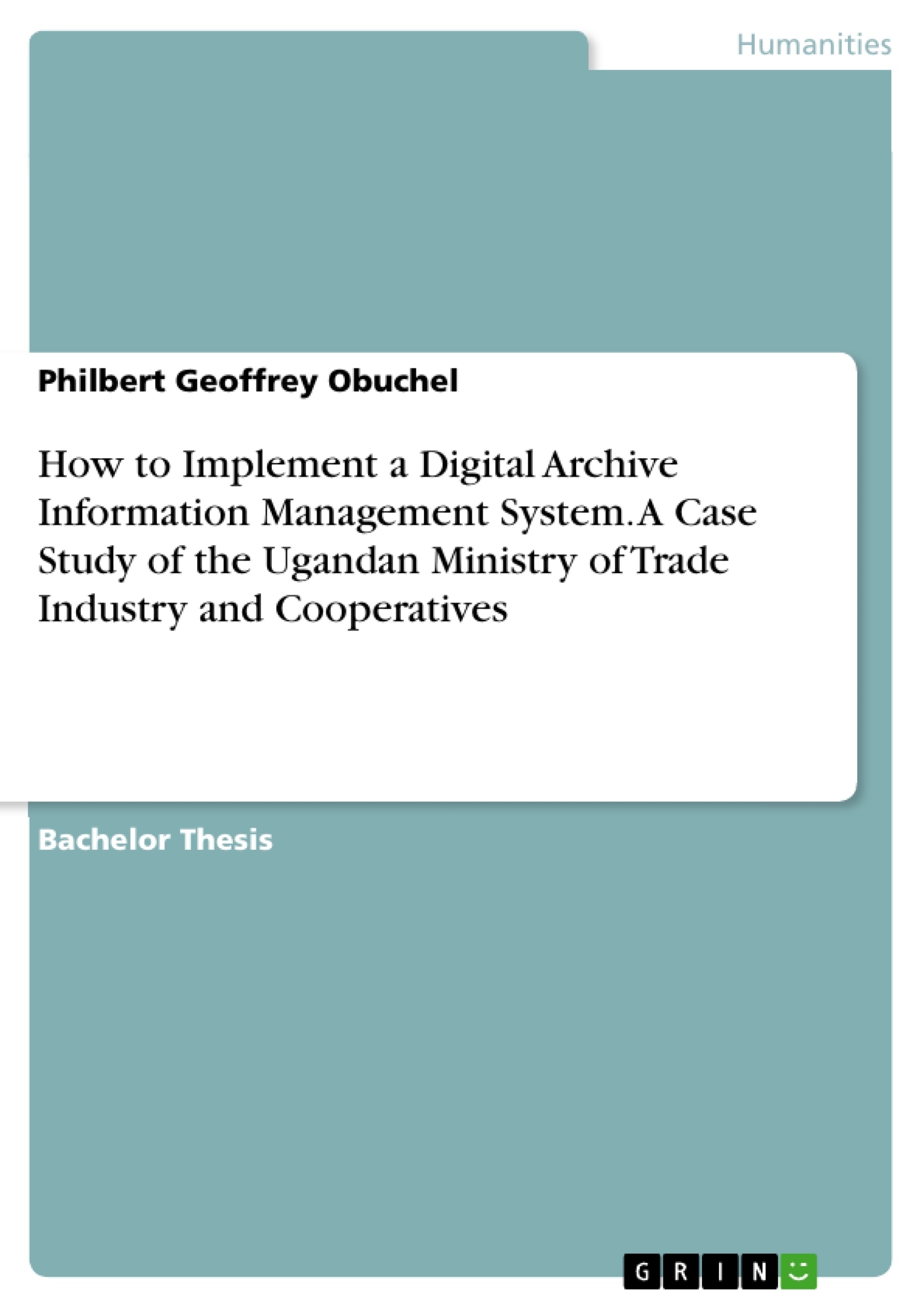This study is concerned with developing an Archives Information Management System for the Ugandan MTIC ( Ministry of Trade Industry and Cooperatives)that will enable a fully automated archive service.
Electronic Records Management involves a comprehensive and structured approach to the long term management of records as tools for the efficient and effective delivery of community and organizations. For an organization to manage its records efficiently all files owned by the organization must be stored somewhere and recorded in the organization’s records management system either manual or electronic. The Ministry of Trade, Industry and Cooperatives is still using the manual file based system to store their files. The Archives Information Management System is a computer based storage system for keeping important files. The manual system employed by the Ministry of Trade, Industry and Cooperatives involves the physical movement and storage of files into the registry and later to the archive. This method wastes time, and is characterized by errors and loss of files among others, so the researcher has developed a system that can capture all file details before the files are sent to the national archive.
Therefor, this study is structured as follows: It starts of by giving a short literature review on this topic before laying out it’s general methodology- Chapter four is concerned with the study design and the implementation of the new system. A special focus hereby is laid upon the training and unit testing. Chapter five concludes the study with a final recommendation.
Table of Contents
APPROVA
LIST OF ACRONY
CHAPTER ONE: INTRODUCTIO
Introduction
1.1 Background of the organization
1.2 Problem Statement
1.3Objective
1.3.1 Main Objective
1.3.2 Specific objectives
1.4 Scope of Study
1.4.1 Geographical Scope
1.4.2 Subject Scope
1.4.3 Time Scope
1.5 Justification of study
CHAPTER TWO: LITERATURE REVIEW
INTRODUCTION
2.1 INFORMATION SYSTE
2.1.1 Subject records can be;
2.1.2 Storage boxes;
2.1.3 Filling cabinets
2.1.4 Shelves
2.1.5 Computer storage devices
2.1.6 Flash Drives
2.1.7 External Hard Drives
2.1.8 Online storage
2.1.9 Re – writable CDs and DVDs
2.1.10 Access
2.1.11 Documentation
2.1.12 Follow up
2.2 MANAGEMENT INFORMATION SYSTEMS (MIS)
2.3 TYPES OF MANAGEMENT INFORMATION SYSTEMS (MIS)
2.3.2 Decision Support Systems (dss)
2.3.3 Executive Information Systems (eis)
2.2.4 Office information systems
2.2.5 Management reporting system
2.2.6 Decision support system
2.2.7 Expert systems
2.2.8 Knowledge work systems
2.2.9 Executive information systems
2.2.10 Relevance of Management Information System (MIS)
2.2.11 GOOGLE
2.2.12 Advantages of using Google
2.2.13 Library perceptions to AIMS
2.2.14 Traditional Stereotypes of Archives
CHAPTER THREE: METHODOLOG
Introduction
3.1 Study Area
3.3 Methods of data collection
3.3.1 Questionnaire
3.3.2 Interview
3.3.3 Observation
3.3.5 System analysis
3.3.6 Weaknesses of a current system
3.3.7 Threats of the current system
3.3.8 Strength of the new electronic system
3.4 Requirement Analysis
3.4.1 Functional Requirements
3.4.2 Non- Functional Requirements
3.5.1 Hardware requirements
3.5.2 Software requirements
CHAPTER FOUR: SYSTEM DESIGN AND IMPLEMENTATIO
4.1 System Design
4.2 Conceptual Design
4.3 Entities and Attributes
4.3.1 Authors Table
4.3.2 Archivists table
4.3.3 Transactions table
4.3.4 Publishers table
4.3.5 files category table
4.3.6 Members table
4.3.7 Files-by –author table
4.3.8 Files table
4.3.9 Files-by-category
4.3.10 Files-in-archive
4.3.11 New Member
4.3.12 Archivists form
4.3.13 Authors form
4.3.14 File categories
4.3.15 Files form
4.3.16 Files by author
4.3.17 Publishers form
4.3.18 Borrowing form
4.3.19 Return form
4.4 Relationship
4.5 Data Entry Forms or Physical Design
4.6 Implementation of the System
4.7 Traini
4.8 Testing And Validation of the Syste
4.8.1 Unit Testing
4.8.2 System testing
CHAPTER FIVE: CONCLUSION AND RECOMMENDATIO
5.1 Conclusi
5.2 Recommendatio
APPENDIX A: TIME FRAM
APPENDIX B: BUDGET ESTIMAT
APPENDIX C: ESTIMATED QUESTIONNAIR
REFERENC
- Quote paper
- Philbert Geoffrey Obuchel (Author), 2020, How to Implement a Digital Archive Information Management System. A Case Study of the Ugandan Ministry of Trade Industry and Cooperatives, Munich, GRIN Verlag, https://www.grin.com/document/539487
-

-

-

-
Upload your own papers! Earn money and win an iPhone X. -

-
Upload your own papers! Earn money and win an iPhone X. -

-
Upload your own papers! Earn money and win an iPhone X. -

-
Upload your own papers! Earn money and win an iPhone X. -

-
Upload your own papers! Earn money and win an iPhone X. -

-
Upload your own papers! Earn money and win an iPhone X. -

-
Upload your own papers! Earn money and win an iPhone X. -

-
Upload your own papers! Earn money and win an iPhone X. -

-
Upload your own papers! Earn money and win an iPhone X. -

-
Upload your own papers! Earn money and win an iPhone X. -

-
Upload your own papers! Earn money and win an iPhone X.

